Abstract
A modeling method that takes into account known points on a geological interface and plane orientation data such as stratification or foliation planes is described and tested. The orientations data do not necessarily belong to one of the interfaces but are assumed to sample the main anisotropy of a geological formation as in current geological situations. The problem is to determine the surfaces which pass through the known points on interfaces and which are compatible with the orientation data. The method is based on the interpolation of a scalar field defined in the space the gradient in which is orthogonal to the orientations, given that some points have the same but unknown scalar value (points of the same interface), and that scalar gradient is known on the other points (foliations). The modeled interfaces are represented as isovalues of the interpolated field. Preliminary two-dimensional tests carried-out with different covariance models demonstrate the validity of the method, which is easily transposable in three dimensions.
Similar content being viewed by others
References
Auerbach, S., and Schaeben, H., 1990, Computer aided design of geologic surfaces and bodies: Math. Geology, v. 22, no. 8, p. 957–987.
Barbotin, E., 1987, Trajectoires de déformation finie et interprétation cinématique. Modéles numé- riques et applications sur des exemples régionaux: unpubl. doctoral dissertation, Université de Rennes 1, 158 p.
Blanchin, R., and Chilés, J., 1993, The channel tunnel: a geostatistical prediction of the geological conditions ant its validation by the reality. Math. Geology, v. 25, no. 7, p. 963–974.
Bran, J., and Pons, J., 1981, Stain pattern of pluton emplacement in crust undergoing noncoaxial deformation, sierra morena, southern spain. Jour. Structural Geology, v. 3, no. 3, p. 219–229.
Courrioux, G., 1987, Oblique diapirism: the criffel granodiorite/granite zoned pluton (southern Scotland): Jour. Structural Geology, v. 9, no. 3, p. 313–330.
Hutton, D., 1982, A tectonic model for the emplacement of the main donegal granite NW Ireland: Geological Soc. London Jour., v. 139, pt. 5, p. 615–631.
Lee, J., and Angelier, J., 1994, Paleostress trajectory maps based on the result of local determi- nations: the “ lissage ” program. Computers & Geosciences, v. 20, no. 2, p. 161–191.
Mallet, J., 1989, Discrete smooth interpolation: ACM Trans. Graphics, v. 8, no. 2, p. 121–144.
Matheron, G., 1971, The theory of regionalized variables and its applications: Ecole Nationale Supérieure des Mines de Paris, Centre de Géostatistique, Fontainebleau, 211 p.
Matheron, G., 1973, The intrinsic random functions and their applications: Advances in Applied Probability, v. 5, p. 439–468.
Matheron, G., 1981, Splines and kriging: their formal equivalence,in Merriam, D. F., ed., Down to Earth Statistics: Solution looking for Geological Problems: Syracuse Univ. Geol. Contrib. 8, p. 77–95.
Renard, D., and Ruffo, P., 1992, Depth, dip and gradients,in Soares, A., ed., Quantitative Geology and Geostatistics: Kluwer Acad. Publ., Dordrecht, The Netherlands, v. 1, p. 167–178.
Wendum, D., 1986, Application des methodes geostatistiques à la météorologie à moyenne échelle. Tech. Rep. S-211., Centre de Géostatistique, école des Mines de Paris, Fontainebleau, 69 p.
Author information
Authors and Affiliations
Corresponding author
Rights and permissions
About this article
Cite this article
Lajaunie, C., Courrioux, G. & Manuel, L. Foliation fields and 3D cartography in geology: Principles of a method based on potential interpolation. Math Geol 29, 571–584 (1997). https://doi.org/10.1007/BF02775087
Received:
Revised:
Issue Date:
DOI: https://doi.org/10.1007/BF02775087




